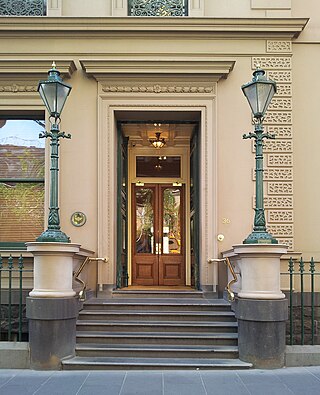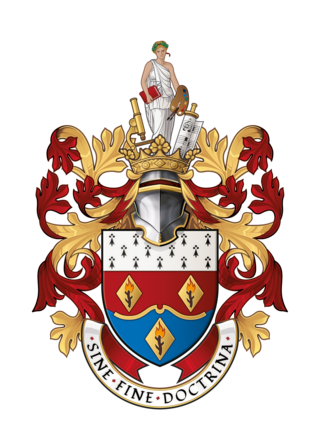
The Melbourne Club is a private social club established in 1838 and located at 36 Collins Street, Melbourne.

The Birmingham and Midland Institute, is an institution concerned with the promotion of education and learning in Birmingham, England. It is now based on Margaret Street in Birmingham city centre. It was founded in 1854 as a pioneer of adult scientific and technical education ; and today continues to offer arts and science lectures, exhibitions and concerts. It is a registered charity. There is limited free access to the public, with further facilities available on a subscription basis.
West Downs School, Romsey Road, Winchester, Hampshire, was an English independent preparatory school, which was established in 1897 and closed in 1988.
The Victoria Cross and George Cross Association is made up of holders of the Victoria Cross (VC), Britain's highest military award for bravery in the presence of the enemy, and the George Cross (GC), the equivalent award for civilians and also for those military personnel who have displayed conspicuous bravery not in the presence of the enemy.
The 1937 Coronation Honours were awarded in honour of the coronation of George VI.

Brooks's is a gentlemen's club in St James's Street, London. It is one of the oldest and most exclusive gentlemen's clubs in the world.
The 1935 Birthday Honours for the British Empire were announced on 3 June 1935 to celebrate the Birthday and Silver Jubilee of King George V.
The King's Birthday Honours 1950 were appointments in many of the Commonwealth realms of King George VI to various orders and honours to reward and highlight good works by citizens of those countries. The appointments were made to celebrate the official birthday of the King, and were published in supplements to the London Gazette of 2 June 1950 for the British Empire, Australia, Ceylon and New Zealand.
The 1949 King's Birthday Honours were appointments by many of the Commonwealth Realms of King George VI to various orders and honours to reward and highlight good works by citizens of those countries. The appointments were made "on the occasion of the Celebration of His Majesty's Birthday", and were published in supplements to the London Gazette of 3 June 1949 for the British Empire, New Zealand, India and Ceylon.
The 1945 New Year Honours were appointments by many of the Commonwealth realms of King George VI to various orders and honours to reward and highlight good works by citizens of those countries. They were announced on 1 January 1945 for the British Empire, Canada, and the Union of South Africa to celebrate the past year and mark the beginning of 1945.
The Livingstone Medal is awarded by the Royal Scottish Geographical Society in recognition of outstanding service of a humanitarian nature with a clear geographical dimension. This was awarded first in 1901.




